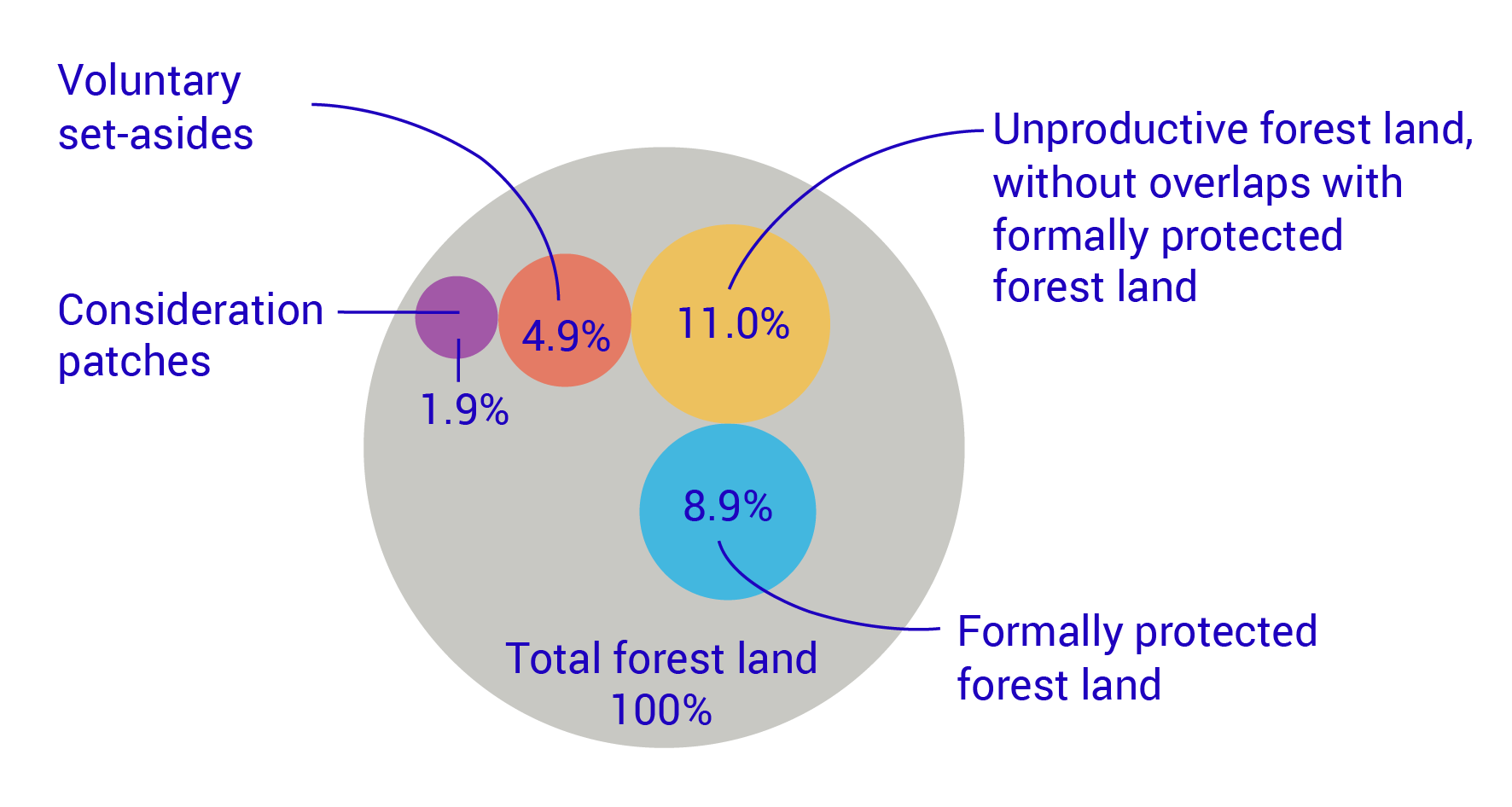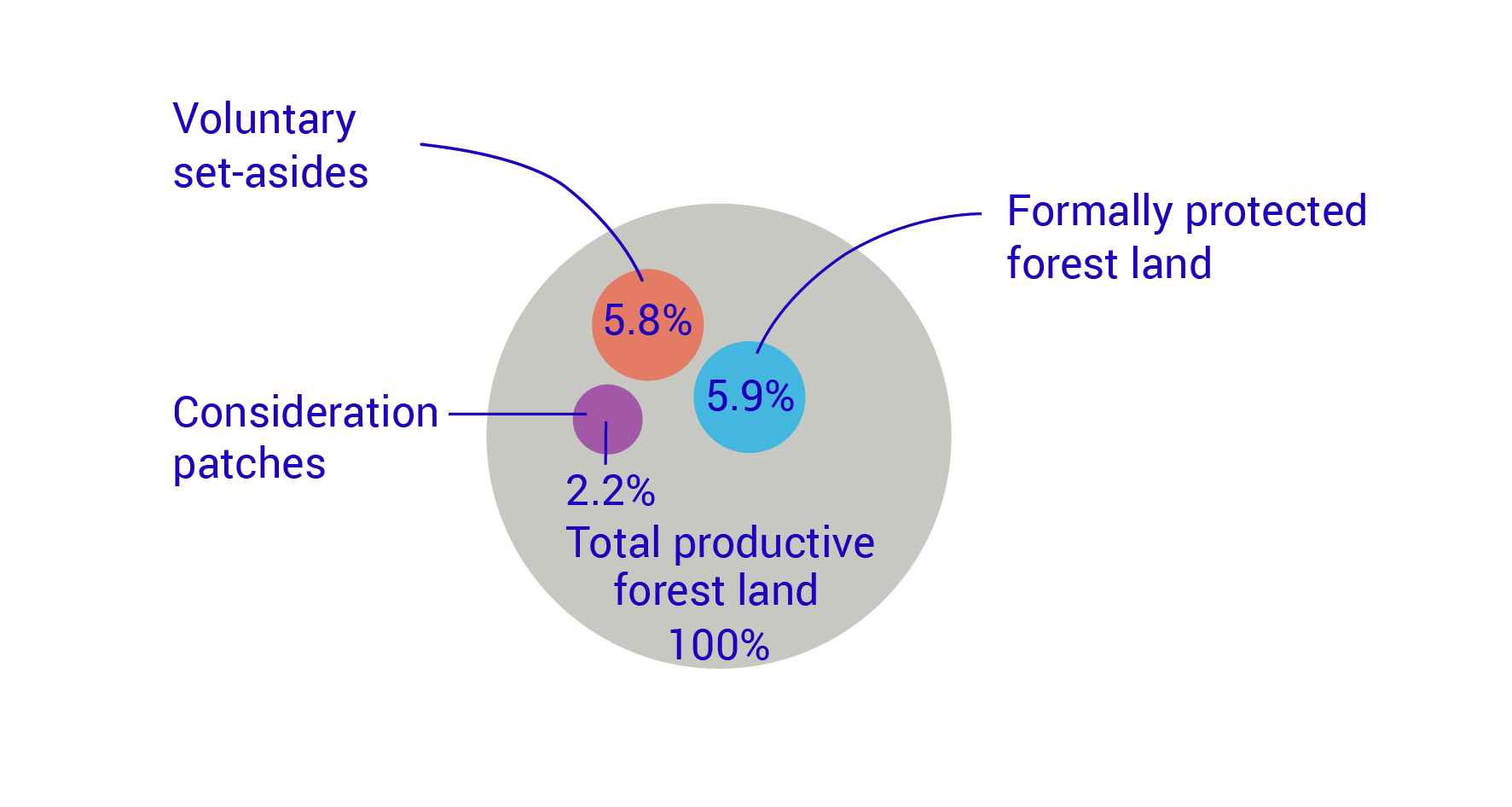Formally protected forest land, voluntary set-asides, consideration patches and unproductive forest land 2022
New formally protected forest land amounted to 29 200 hectares
Statistical news from Statistics Sweden 2023-06-29 8.00
In 2022, formally protected forest land increased by 29 200 hectares, 22 000 hectares of which is productive forest land. Voluntary set-asides have an estimated increase of 52 600 hectares since 2021.
At the end of 2022, formally protected forest land amounted to almost 2.4 million hectares, which corresponds to 8.9 percent of Sweden’s total forest land. Of the formally protected forest land, more than 1.3 million hectares consists of productive forest land, which corresponds to 5.9 percent of Sweden’s total area of productive forest land.
Voluntary set-asides amounted to 1.4 million hectares, which corresponds to 5.8 percent of Sweden’s area of productive forest land and 4.9 percent of the total area of forest land.
A preliminary estimate of consideration patches for regeneration felling amounted to an area of 0.5 million hectares in 2022, which corresponds to 2.2 percent of Sweden’s area of productive forest land and 1.9 percent of the total area of forest land.
Sweden’s total area of unproductive forest land amounted to 4.4 million hectares, although large parts are overlapped by formal protection. Unproductive forest land without formal protection amounts to 3.1 million hectares, or 11 percent of Sweden’s total area of forest land.
| Areas in hectares, without overlapping areas | Share of Sweden’s total forest land | ||||
|---|---|---|---|---|---|
| Forms | Productive forest land | Total forest land | Productive forest land | Total forest land | |
| Formally protected forest land | 1 348 800 | 2 398 000 | 5.9% | 8.9% | |
| Voluntary set-asides | 1 372 500 | 1 372 500 | 5.8% | 4.9% | |
| Consideration patches | 525 500 | 525 500 | 2.2% | 1.9% | |
| Unproductive forest land | 0 | 3 064 700 | 0.0% | 11.0% | |
Source: Statistics Sweden, the Swedish Environmental Protection Agency, the Swedish Forest Agency and the Swedish University of Agricultural Sciences. Areas are rounded to even 100s.
Areas and percentages of the four types are not summed in the official statistics. This is due to several factors, including major legal distinctions between the types concerning how they can affect land use on the area where they are located. The methods used to calculate the areas also differ greatly, mainly based on which data is available as a basis for the statistics. Furthermore, these statistics are not measured in relation to national or international goals. All this means that aggregates may be misleading.

Source: Statistics Sweden, the Swedish Environmental Protection Agency, the Swedish Forest Agency, and the Swedish University of Agricultural Sciences National Forest Inventory. The size of the circles shows the actual proportions. The percentages in the figure should not be added together due to methodological and legal differences between the parts.

Source: Statistics Sweden, the Swedish Environmental Protection Agency, the Swedish Forest Agency, and the Swedish University of Agricultural Sciences National Forest Inventory. The size of the circles shows the actual proportions. The percentages in the figure should not be added together due to methodological and legal differences between the parts.
Definitions and explanations
Forest land
Under the Forestry Act (1979:429), forest land is defined as a coherent area in which trees are higher than five metres and the crown cover is more than ten percent or there are conditions to attain this height and crown cover without production-enhancing measures.
Productive forest land
Under the Forestry Act, productive forest land is defined as forest land that, according to generally accepted criteria, can produce on average at least one cubic metre of wood per hectare and year.
Types of forest land
Statistics Sweden presents statistics on four different types of forest land: formally protected forest land, voluntary set-asides, consideration patches for regeneration felling, and unproductive forest land. These statistics are produced in a collaboration between Statistics Sweden, the Swedish Environmental Protection Agency, the Swedish Forest Agency, and the Swedish University of Agricultural Sciences.
The four subsets included in the statistics are called “types” here. They are described in the government assignment (N2018/04159/SK) as the subsets on which these statistics are to be distributed. The types are:
1. formally protected forest land,
2. voluntary set-asides,
3. consideration patches for regeneration felling, and
4. unproductive forest land.
Formally protected forest land
Forest land regulated by laws and ordinances, as well as agreements, entered into individual decisions. In these statistics, it is a collective term for various instruments for the protection of forest land. These are present in both productive and on unproductive forest land. The instruments included in the statistics are:
1. National parks
2. Nature reserves with regulations against forestry
3. Habitat protection areas
4. Natura 2000 with designated forest habitats
5. Nature conservation agreements, including “ekoparker” (nature reserves) and the White-Backed Woodpecker Action Plan
6. Agreement between government agencies between the Swedish Environmental Protection Agency and the Swedish Fortifications Agency
7. Habitat protection areas and nature reserves for which the decision is not final and binding
8. Land compensation for the establishment of nature reserves.
Voluntary set-asides
Areas of productive forest land on which landowners voluntarily decided not to carry out any measures that can harm natural values, cultural environments, or social values.
Consideration patches
Small areas of productive forest land that have been made available, voluntarily, or pursuant to the Swedish Forest Care Act, for regeneration felling. The areas are preliminary estimates based on the most recent definitive five-year average value in 2017/2018.
Unproductive forest land
Forest land that, according to generally accepted criteria, is not able to produce on average at least one cubic metre of wood per hectare and year. Examples of unproductive forest land include subalpine birch forests, tree- or shrub-covered mires, and sparsely wooded rocky land areas.
Changes over time
Values for consideration patches and voluntary set-asides have been revised continuously due to continuous quality increase in method and input data. In conjunction with the publication of the 2020 values, new values for the previous years are also reported.
Publication
A more detailed report of this survey is published in the Statistical Report:
Next publishing will be
The next statistical news in this series will be published in 2024.
Statistical Database
More information is available in the Statistical Database
Feel free to use the facts from this statistical news but remember to state Source: Statistics Sweden.
